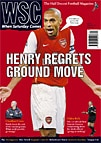 The problem of Paris Saint-Germain’s notoriously far-right supporters exploded when a policeman opened fire after a racist mob confronted fans of Hapoel Tel-Aviv. Nicolas Hourcade reports
The problem of Paris Saint-Germain’s notoriously far-right supporters exploded when a policeman opened fire after a racist mob confronted fans of Hapoel Tel-Aviv. Nicolas Hourcade reports
Thursday November 23, 11pm, the Porte de Saint‑Cloud area of Paris, near the Parc des Princes. Paris Saint-Germain have just been humiliated 4-2 in the UEFA Cup by an average Hapoel Tel-Aviv team. The hardest PSG fans are running at opposing supporters. According to the initial results of the investigation, one of the Hapoel fans was being chased by a group of Parisians when a 32-year-old black man, only identified as a plain-clothes policeman, intervened. He tried to break up the group with tear gas. But in the face of their aggression he retreated, fell down, took out his gun and fired, killing one of his assailants and seriously injuring another. He sought refuge in a McDonald’s, which was then attacked by PSG fans screaming racist abuse until the police broke up the crowd.
This episode shocked the whole of France. It is only the second time that an incident involving fans has led to a death (in 1984 a supporter was killed by a flare). Immediately, public opinion blamed the violence and racism of the group of fans, and in particular the part of the stadium they inhabit.
The fans in question were from the most notorious stand in France – the Boulogne, named after the district next to the ground. The home of French hooliganism, the Boulogne is synonymous, in the eyes of the public, with violence, racism and fascism. At the end of the 1970s PSG were struggling to attract a fervent fan-base and so decided to offer cheap tickets in the Boulogne to young people. Influenced by their English counterparts, these fans created the “Kop of Boulogne” (KOB), an area that was soon immersed in hooligan culture. In the middle of the 1980s skinheads took over part of the Boulogne, lending the name far‑right connotations. By the end of that decade, the Boulogne was the rallying point not only of the most loyal PSG fans, but also of the most extremist.
To give their supporters an alternative, the PSG board backed the creation of a second kop at the Auteuil end of the ground. Both ends are decked out with banners and flags, but the Auteuil is completely multicultural whereas the Boulogne remains white. But it’s not simply a matter of the Boulogne being a fascist zone. The Boulogne Boys, a large, Italian-style ultra group, coexist with smaller ones (Gavroches, Rangers) and notably with various bands of “independents”, as French hooligans call themselves. The KOB is unquestionably politicised, in so far as only whites dare enter it and “political” slogans (such as “France for the French”) are chanted. However, all purely political groups that have tried to infiltrate have been rejected, sometimes violently, by the occupants of the Boulogne protective of their autonomy. Moreover, PSG chants are always much better taken up than political ones.
Even if some fans are proud to demonstrate their extremist leanings, others refuse to be considered fascists. The Boulogne Boys and some “independents” stress their unpolitical stance, certainly to ensure they do not tarnish their image, but also because a proportion of them genuinely do not have extreme-right views. So the KOB is drawn from various areas: far-right extremists expounding their ideas, sometimes violently; hooligans, who are there for the thrill of fighting rather than politics; and those fans drawn to the atmosphere of the KOB, to its edgy image or its longevity compared to the Auteuil.
Alongside the Boulogne problem, this incident brought into question the way hooliganism is dealt with in France. It is difficult to understand why the number of police present was the same as for a normal game. After all, this match was attractive to the Parisian hooligan – there had already been incidents when PSG played Israeli clubs and in matches against Galatasaray in 1996 and 2001. There were no CRS (riot police) at the Porte de Saint-Cloud, even though it is renowned as one of the most dangerous areas. The ambulance services (as much for the policeman as for the injured fans) took a long time to arrive.
Some question whether PSG are doing enough to combat the hardcore hooligans, given that officials meet their representatives openly. Last year, the club directors scarcely supported Tigris, an ultra group from the Auteuil, when it criticised the racism in part of the Boulogne. With the disbanding of Tigris after many months of violent conflict, PSG’s directors hoped for a return to peace. They have had a rude awakening.
From WSC 239 January 2007. What was happening this month